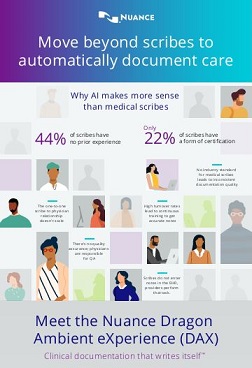Move beyond scribes to automatically document care
Embrace innovative solutions that do so much more than document care. Explore the infographic to learn how you can automatically document care at scale—easily and efficiently.
Medical scribes downfalls
Lack of experience
44% of scribes have no prior experience
Quality assurance
Only 22% of scribes have a form of certification
High turnover rates
Lead to continuous training to get accurate notes
No industry standards
No industry standards result in inconsistent documentation quality
Why AI makes more sense than medical scribes
As clinical documentation demands have increased, so has frustration and burnout among medical staff. On average, physicians spend twice as much time documenting care as they do delivering it.
Medical scribing programs may offer some initial relief, but to really alleviate this burden, organizations are turning toward less intrusive, more sophisticated AI‑powered solutions that scale to their needs and work with their workflows.
Get the infographic to learn how you can automatically document care at scale.
Want to learn more? Read our latest blog(Open a new window).
Meet the Nuance Dragon Ambient eXperience (DAX)
Nuance DAX, an ambient clinical intelligence (ACI) solution, automatically documents patient encounters at the point of care accurately and efficiently. For use in office and telehealth settings, in all ambulatory specialties including primary and urgent care, DAX can help:
Increase operational efficiency by reducing time spent documenting care
Boost physician satisfaction by decreasing administrative burdens and burnout
Improve the patient experience by enabling physicians to focus on their patients

Better ROI, improved patient experience, and burnout reduction
Dr. Robert McDermott of Allergy, Asthma and Immunology of the Rockies discusses the challenages of their previous scribe program and how they improved the patient‑clinician experience and reduced burnout with DAX.

